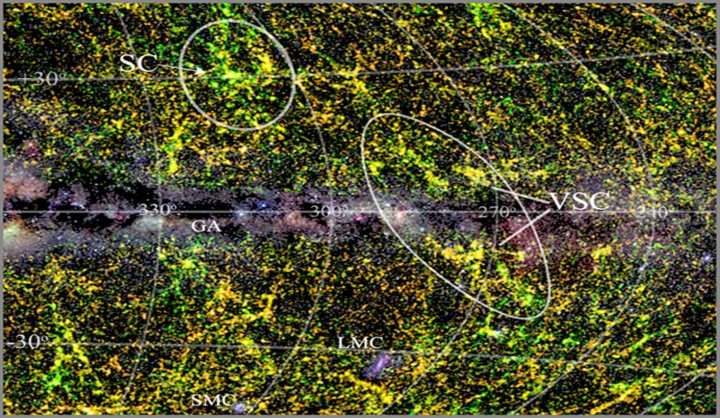Maverick Life, Sci-Tech
A giant leap for astronomy, another giant leap for South Africa

Earlier this year, an international team of astronomers that included two South Africans managed to explore behind thick clouds of dust particles in the Milky Way that had previously made it impossible to map large parts of the sky. Now, continuing the quest to discover massive areas of the universe that have previously been a mystery, a colossal supercluster of previously hidden galaxies has been revealed. It covers more sky than the biggest supercluster previously known to man, with a gravitational pull that could have a massive cosmological impact on the galaxies around it – including ours. Understanding it could unveil some puzzling secrets of where we are going, and why. By MARELISE VAN DER MERWE.
The Hemingway law of motion: gradually, then suddenly. So it’s been for Professor Renee Kraan-Korteweg, who served on the team of astronomers that announced their groundbreaking discovery of 883 new galaxies in February 2016, after nearly two decades of painstaking research. The discovery, which explained a previously misunderstood phenomenon known as the Great Attractor, was a major breakthrough. Now, further developments appear to be coming thick and fast – with more on the horizon.
“We are like explorers of the universe,” Kraan-Korteweg told Daily Maverick in February. “It is just like in the past, when they started making maps of the Earth. We are making maps of the sky.”
Kraan-Korteweg led the team that has just announced their discovery of another massive supercluster of galaxies, also previously obscured behind dust and stars around the plane of the Milky Way. The concentration of galaxies, which they have dubbed the Vela supercluster, is located in the constellation Vela – in the largely unknown area rather aptly called the Zone of Avoidance (ZOA), for the challenge it poses in viewing distant objects.
The team, from South Africa, the Netherlands, Germany and Australia, is led by Kraan-Korteweg (UCT). It also includes Michelle E. Cluver (UWC), Maciej Bilicki (Universiteit Leiden), Thomas H. Jarrett (UCT), Matthew Colless (Australian National University), Hans Böhringer (Max-Planck-Institut) and Gayoung Chon (Max-Planck-Institut).
Superclusters of galaxies are the most colossal known structures in the Universe. They consist of clusters embedded in wall-like structures of galaxies that can span up to 200-million light-years across the sky. The most famous is the Shapley Supercluster, some 650-million light-years away. It is believed to be the largest of its kind in our cosmic neighbourhood. (A light-year, for some perspective, is approximately 9.5 trillion km.)
The Vela supercluster, however, is no slouch either. Some 800-million light-years away, it covers even more sky than Shapley and is a force to be reckoned with – literally. Such a massive concentration of galaxies has an immense gravitational pull, and shapes the pattern of cosmic flows on enormous scales, UCT spokesperson Thami Nkwanyane said in a statement. Co-author of the team’s paper, Discovery of a prospective supercluster in the ZOA in Vela, Dr Maciej Bilicki explains, “Despite its large distance from us, the Vela supercluster might have a significant influence on the motion of our Local Group of galaxies, which includes the Milky Way, and could help resolve some puzzles in the observed flows of galaxies around us.”
The discovery, although she and colleague Dr Michelle Cluver were looking to better understand the area, came as a shock, says Kraan-Korteweg. “I could not believe such a major structure would pop up so prominently,” she says.
“As I looked at each new spectrum, it became obvious we were uncovering a massive network of galaxies, extending much further than we had ever expected,” adds Cluver.
The discovery was based on multi-object spectroscopic observations of thousands of partly obscured galaxies, which in plain English means, more or less, that the researchers used multiple complementary observations to gather pieces of the puzzle, which they then put together to construct a more thorough understanding of the bigger picture. In 2012, they used the refurbished spectrograph of the Southern African Large Telescope (SALT) to confirm that eight new clusters resided in the Vela area; subsequent observations with the Anglo-Australian Telescope in Australia added thousands of galaxy redshifts, which revealed just how vast the new structure was.
Looking to the future, the researchers say there is a great deal of work lying ahead. Follow-up observations will be necessary to fill in the gaps regarding the full extent, mass, and influence of the Vela supercluster. There is also a great deal more exploring to do.
“So far this region of the sky is sparsely sampled, while the part closest to the Milky Way has not been probed at all because dense star and dust layers block our view,” the statement added.
South Africa is likely to play a central role in navigating this (literally) uncharted territory. The central core of the supercluster can only be mapped with dedicated radio surveys that can penetrate the Zone of Avoidance. Here, the South African Square Kilometre Array Pathfinder, MeerKAT, can pave the way, and it can do so as early as next year.
“We have proposed to use this powerful radio telescope in early-science mode, when 32 of its total of 64 dishes are in place, during 2017, for a systematic search of the fully hidden core of the supercluster,” says Kraan-Korteweg.
Meanwhile, the supercluster’s outer edges will be mapped with the new instrument Taipan, which will also start science operations in 2017. Taipan includes an innovative starbugs optical fibre positioner – put simply, a tiny robot carrying bundles of fibre optics that can capture light from distant galaxies – and a purpose-built spectrograph.
The future, say the researchers, looks very promising, and it’s likely that these previously unknown regions of the sky will be much better understood in the near future. Co-author Professor Matthew Colless, from the Australian National University, said the current study was “intriguing evidence” that would be tested in the next year. The upcoming Taipan optical survey, as well as the Wallaby and MeerKAT radio surveys, would map the region more thoroughly and “reveal any shy giants hiding behind the Milky Way”. Astronomically speaking, the future – not least in South Africa – looks big. Prepare to feel small. DM
The new article entitled ‘Discovery of a prospective supercluster in the ZOA in Vela’ will be published in Monthly Notices of the Royal Astronomical Society: Letters 2016; doi: 10.1093/mnrasl/slw229 Authors: Renée C. Kraan-Korteweg, Michelle E. Cluver, Maciej Bilicki, Thomas H. Jarrett, Matthew Colless, Hans Böhringer and Gayoung Chon.
Read more:
- Nearly 1,000 hidden galaxies mapped behind the Milky Way – and SA helped find them, in Daily Maverick
Photo credit: Thomas Jarrett (UCT), based on data from the 2MASS Photometric Redshift catalogue (Bilicki et al. 2014) and the All-Sky Milky Way Panorama (Mellinger 2009).
The image displays the smoothed distribution of galaxies in and around the Vela supercluster (big ellipse; VSC). Colour indicates the distance ranges of all galaxies within 500-1,000 million light years (yellow is close to the distance of the Vela supercluster, green is nearer and orange further away). The large ellipse marks the approximate extent of the Vela supercluster, crossing the Galactic Plane, where an optical image of the Milky Way reveals where dust obscuration and sheer density of foreground stars defines the Zone of Avoidance. LMC and SMC are the Large and Small Magellanic Clouds, satellites of the Milky Way.
The VSC structure was revealed thanks to the new low latitude spectroscopic redshifts. Note its prominence on either side of the plane of the Milky Way. It would be highly unlikely for these cosmic large-scale structures not to be connected across the Galactic Plane, where data is currently missing. The structure may be similar in aggregate mass to the Shapley Concentration (SC), although much more extended, and hence less concentrated. The so-called ‘Great Attractor’, located much closer to the Milky Way, is an example of a large structure that crosses the Galactic Plane, although much smaller in extent than VSC. The central, dust-shrouded part of the VSC remains unmapped in the current Vela survey. To chart this obscure (d) part of the sky the team plans to use radio telescopes like MeerKAT.

















 Become an Insider
Become an Insider